Choosing Equipment
Plaer

Skates
The fit around the ankle and heel is most important, since if it loose you will lose your power and get sore feet. Ensure that the boots fits snuggly along the sides of the ankle. Special insoles are recommended for those who wear arch supports in ordinary footwear. It is also important to be able to flex the ankle without the skates widening and losing its form. A material that is resilient in the flex returns energy at the end of the thrust phase and contributes to higher frequency, in other words you can accelerate faster.
A hard skate makes high demands on precise balance and muscle strenght. A softer skate is more forgiving when shifting from the outside to inside of the blade and vice versa.
The distance from the ice to the boot is also important. It should be possible to angle the skate when turning without boot touching the ice.
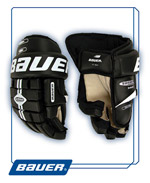
Gloves
When you choose gloves it is important that the stick doesn´t twist in your hands. Good grip means better energy transfer from your body to the stick. This energy you exploit for shots, dekes, passes and reception. A good glove should also allow great wrist movement to make stickhandling easier. The size of the glove´s fingers and the thickness of the liner are also important. Gloves that are too large means there is a gap between your hand and the glove. Last, but not least, the fingers should be flexed, including the thumb, so that you can move them without resistance.

Shin pads
Naturally, shin pads have to fit in lengh but they should also be laterally stable. If not, they can glide sideways and expose the areas they are intended to protect. The right size is when the pad´s knee cap sits in the middle of your knee and when the shin pads provide good protection right down to the ankle and along the sides of your calves. Finally, a good tip: put your shin pads in front of the skate tongue to protect your ankle tendons.
Elbow pads
Next after a helmet, elbow pads are probably the most important pad for really young players. When you fall to the ice it is often the elbows that land the hardest. Just like shinguards fit is important. They are not to twist or slide down. It goes without saying the elbow pads have to have good chock-absorbing properties.
The way to know that you have bought the right gloves, elbow and shoulder pads is to check that as little as possible of your body exposed. This means you have the best protection and can avoid injuries.

Pants
The most important function is to protect your hips and the front of your thighs. Don´t buy pants that are too big since they can impede movement, particularly in cross over skating. Test the fit by placing one leg in front of the other. If you can do this freely then the pants are the right size. Kidney pads are also important for players old enough to play games where body checks are allowed.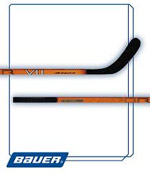
Sticks
The stick´s shaft should be flexible so that you can use its resiliency when shooting. The blade should be as rigid as possible without losing feel when deking and receiving. The corner, between shaft and blade, should be rigid because soft corners reduce shot and passing precision. A flexible shaft and hard blade combined with good rigidity is a good guide when you test the stick before buying. When you test the shaft flex remember to hold your upper hand where you intend to shorten the stick.
The angle between the shaft and blade differs from stick to stick. You can see this by putting the soles (the bottom of the blade) together and then compare the angle of the shafts. A lower angle requires a longer shaft. Extra length gives you better reach when you passing and recieving in extreme situations. The extra length also means you can handle the puck better in extended positions.
A steeper angle and somewhat shorter stick makes it easier to shoot high. Choosing the blade´s hook is entirely individual and is determined by what works best for you. If you dream of playing in the NHL you should know that they don´t allow blades to be as sharly curved as in Europe.
It´s generally said that defenders should have bigger blades than forwards and consequently centers should have a medium-sized blade.
Goalie
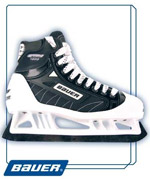
Skates
The first, and maybe the most common, question goalie coaches are asked is ?When should I get goalie skates?? The answer is simple: a player plays best with skates designed for the job. This applies equally for goaltenders and skaters. There are several reasons. Goalie skates offerbetter protection than ordinary ones and they provived better balance and a lower center of gravity, two important factors when goalie want to react quickly and move about the goal mouth. In other words, if you have decided to play goal then you should have goalie skates. You´ll discover an entirely new dimension in playing goal. Other things to remember:
- make sure that your skates are sharpened the way you want them to play your game. Get a sharp edge because it is important that they ?bite? so that you can get to the puck quickly when you push off.
- wearing thin socks gives you a better feel for your skates.

Sticks
You stick is perhaps the most significant piece of your equipment. It has to be the right size. Do the following to determine the ideal stick size just for you:
- Assume your basic stance.
- Plase the stick a little bit in front of your pads.
- Make sure that the blocker doesn´t ?double-cover? your pads. If the size is correctthe full length of the stick blade should be in contact with the ice. Avoid cutting the shaft too much since this affects the balance of the stick. File down the paddle instead of sawing the stick. If you have to cut too much you have the wrong size stick.
The stick´s center of gravity should be 5-8 cm down the paddle. Tape the blade fro heel to toe. Have a reasonably sized knob. You need the knob to hold onto when poke checking and passing plus it makes easier to pick up the stick from the ice if you drop it. When you´ve found the stick that´s perfect for you do not throw it away- use it as a template for the next one. Do not use a senior stick until you´re not big enough.
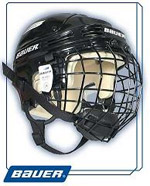
Mask
A mask or a helmet with a cage is a matter of personal preference. It is seldom wise to try to be economical and buy equipment that you can grow into, and the same applies to masks. A mask that is too large will collide with your chest and arm protector because the chin is too low and this makes it difficult to see pucks that are close to the goalie´s skates or body.
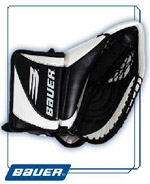
Gloves
In order to obtain the right feel the fingers of the gloves should not be longer than one centimeter more than your fingers. Take a good care of your gloves! Wear them o lot when they are new so that you get your personal shape on the catcher. Also, work often with both the gloves and stick to make easier to find a good grip and position when using the stick in the game. Never take the gloves off when practicing shooting or passing.

Chest and arm protector
Your the most important pads! You can move feely in the goal and dedicate all your concetration on the puck if you don´t feel you can trust your equipment abd this applies particularly to your chest and arm protector. Pucks will hit your shoulders, collarbone, chest, stomach and arms at every practice. This should not hurt so that you can quickly focus on the next puck. In other words, don´t event think about using you savings to paint your mask until you have a good chest and arm protector! When determining the size of your chest and arm protector you should think about your shoulders, elbows and chest. Your shoulders and elbows are to fit properly in the caps. The arms should not extend more then 3 cm into your gloves. The chest protectorshould overlap your pants, but not so that it interferes with your movement.
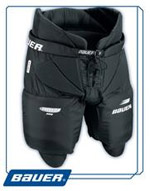
Pants
When you are around the age of ten you choose your proper goalie pants, otherwise to do not have good protection againts pucks. The pants should be overlapped by both the chest and arm protector as well as your leg pads and held up by a pair of suspenders.
Shopping basket
Basket empty.










